We have created 10 proven blog post templates to make writing easier so you can match the intent and content format of the topic you will write about.
These blog templates with actionable steps will save you time drafting and writing copy, but they will also provide you with the best chance of ranking high and driving organic traffic.
What is a blog post?
A blog post is a piece of web content that contains information about a topic that people are searching for or are interested in.
Blog posts are used to attract, educate, inform, or persuade your audience to take action.
But there are 3 things to consider before starting a post.
- Keyword Research
- User Intent
- Content Format
Do keyword research before writing anything
A guest post writer just approached us with some blog post ideas, but there was no traffic potential behind their pitch.
We have a content plan that targets keywords and topics with the potential to drive organic traffic.
There are plenty of tools such as Moz, Ahrefs, Semrush, and Ubersuggest that provide estimated traffic for keywords you wish to target.
User intent and content format
Once you’ve chosen a keyword or topic with potential for traffic, the next step is understanding the user’s intent behind the keyword or topic.
We’ve created this table to help you match the intent behind the keyword you are targeting and the content format you should use to write your blog post.
| Query or title includes | Intent | Content Format |
| How | The user is searching for instructions to get a result or outcome. | How To Guide |
| What | The user seeks an answer to a question. | What Is Article |
| Best or Top | The user wants to find, use or buy from a recommended list of products, services, or solutions. | Best Post |
| List, Best, Number | The user seeks recommended resources, products, services, and tips | List Post |
| Service | The user wants a service that solves their problem. | Service Page |
| Review | The user is familiar with a product, wishes to know more, or is considering purchasing it. | Product Review |
| Comparison, VS | The user wants to see the features and benefits of competing products or services before buying the right one. | Comparison Article |
| Alternatives | Users may know about or were dissatisfied with using a product, service, or company and want another similar solution. | Alternatives Article |
Let’s start with the first content format.
Alternatives post
An alternative article gives readers choices when searching for a product or solution.
Readers may be aware of or dissatisfied with a product, service, or company and want a similar solution.
Alternatives post title
The title of your alternative article contains a number, the word “alternative” or “alternatives to,” followed by the product or service and the product/service category.
Example:
“5 Alternatives to Google search engine” or “Google Alternatives – 5 other search engines to consider.“
Alternatives post introduction
In the introduction of an alternative blog post, you should let readers know you will be writing about several alternative products or services related to the target keyword.
Here’s a little formula or template you can use to write your introduction.
- What the product is.
- The category it serves.
- Seed doubt if it is the right product, solution, or company for the reader.
Example:
“Moz is a quality all-in-one SEO toolset.”
This is an excellent introduction from Robbie’s post explaining alternatives to Moz.
He’s described the product and category in 9 words.
Another example:
“Are you looking for a list of search engines that you can use when doomsday hits Google?”
This article is seeding serious doubt about the future of Google to this searching for alternative search engines.
After writing the introduction, you should create an outline for your post.
Alternatives post headings and subheadings.
We’ve found that using these headings and subheadings is the best way to structure an alternatives blog post.
- What is the target keyword?
- Features
- Why do people use it
- Pricing
- Alternative 1
- What is alternative 1?
- Alternative 1 features
- Alternative 1 vs. target keyword
- Alternative 1 best for
- Alternative 1 pricing
Now follow the same steps for the second, third, and subsequent alternatives.
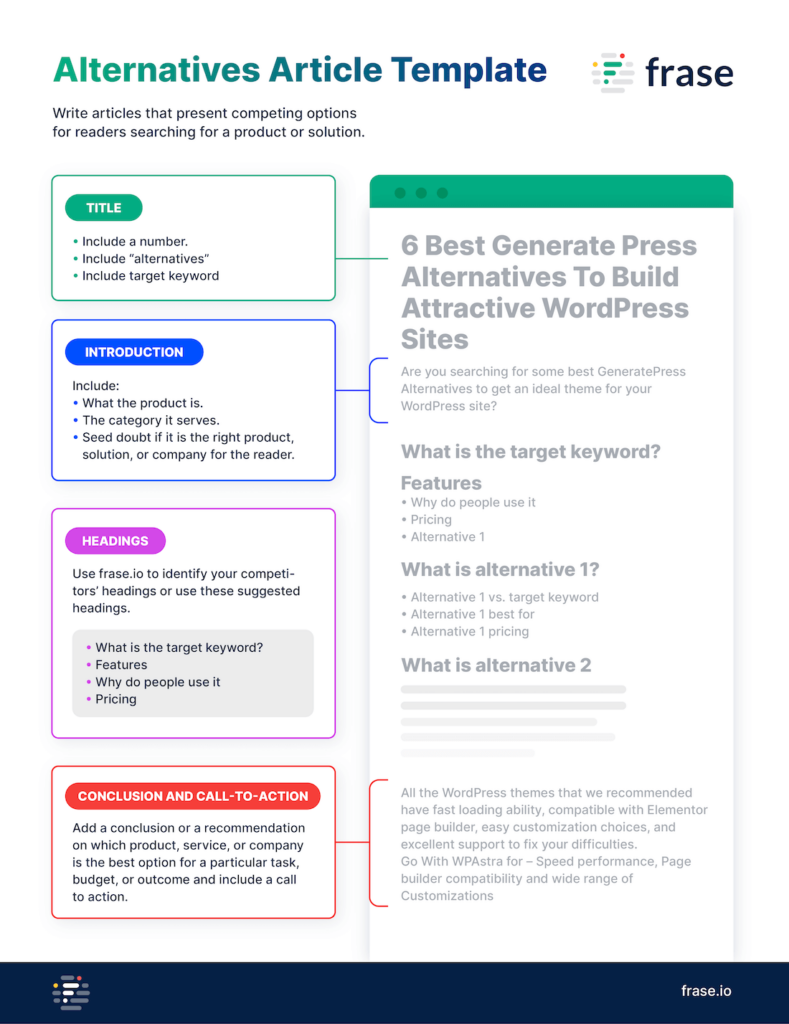
Conclusion for an alternative post
Add a conclusion or a recommendation on which product, service, or company is the best option for a particular task, budget, or outcome and include a call to action.
Conclusion Example:
Look at the conclusion where the author suggests 3 alternatives depending on which product features are most important to you.
“Go With WPAstra for – Speed performance, Page builder compatibility, and wide range of Customizations”
Examples of alternatives articles
- Moz Alternatives
- GeneratePress Alternatives
- TransferWise Alternatives
- WordPress Alternatives
- 48 Search Engines: Best Google Alternatives for 2021
- Best DJI GO 4 app alternatives to fly DJI Mavic drones
Next,
Beginners Guide
A beginner’s guide is an article that provides comprehensive coverage of a topic.
Beginner’s guide title
The title of your beginner’s guide should include the keyword and state that it’s aimed at beginners.
Example:
A Beginner’s Illustrated Guide To Ableton 10 Live (How To Use It!)
Another example:
Ecommerce product photography tips: a beginner’s guide.
Beginner’s guide introduction
Invite readers to learn about the target keyword and how they will benefit from reading this guide.
Example:
Here’s a great example of an introduction to a beginner’s guide.
“Today, I give you a complete step-by-step Shopify tutorial for beginners.“
Another example:
Or how about this introduction to Bitcoin.
“Learn where Bitcoin came from, how it works, how to mine it, and how to buy and sell it.“
While not explicitly mentioning this is a beginners’ guide, the introduction clearly outlines what readers should expect.
Headings and subheadings for a beginner’s guide
Use these suggested headings in your beginners’ guide post.
- What is the target keyword?
- Explain the topic or target keyword.
- Why does this topic or target keyword matter?
- Getting started
- Describe what equipment and resources the reader needs to get started.
- Step 1
- Describe and demonstrate this step.
- Step 2
- Describe and illustrate this step.
And subsequent steps.
- Question 1
- How to answer this question or solve this problem.
- Question 2
- How to answer this question or solve this problem.

Conclusion and call to action
In the conclusion of a guide, you should remind the reader about the topic or target keyword and the benefits and include a call to action.
Example:
This conclusion reminds readers that “skateboarding is fun” and offers an infographic as a call to action.
Examples of beginners’ guides
- Ableton for Beginners
- Shopify for Beginners
- Skateboarding for Beginners
- E-commerce Product Photography for Beginners
- BitCoin for Beginners
Best Post
Best posts (similar to list posts) include a list of recommended products, services, or resources within a category the readers want to find, use or buy.
Best post title
Best post titles should start with a <number>, “best,” then the keyword, then “for/to buy/near/on/to,” and the year.
Example:
Look at this page title that follows the best post title formula.
The 20 Best Airbnb’s in Canberra, Australia (followed by the year) which the author really should update.
Best post introduction
Here are a few tips for writing introductions.
Start the best post introduction, such as “We are here to help you find/ choose/use the best keyword for you/your business.
A great keyword can make the difference, and we’ve picked the best number.“
Example:
Here’s an introduction following this formula: “I have picked some best android apps for YouTubers by which they can easily manage their channel and create amazing content for themself.”
Headings and subheadings
Use these suggested headings and edit the template.
Product 1
- What is the product/service?
- Features/Benefits/Specifications
- Who uses it
- Final thoughts about the product
- Pricing and link to the product
- Refer to Google’s advice about including evidence such as visuals, audio, or your own experience with the product, to support your expertise and review.
Product 2
- What is the product/service?
- Features/Benefits/Specifications
- Who uses it
- Final thoughts about the product
- Pricing and link to the product
- Refer to Google’s advice about including evidence such as visuals, audio, or your own experience with the product, to support your expertise and review.
Buying Guide
- Consider adding a list of factors before buying this type of product.
FAQs
- If there are any FAQs in the SERPs, consider adding a list of questions to answer.
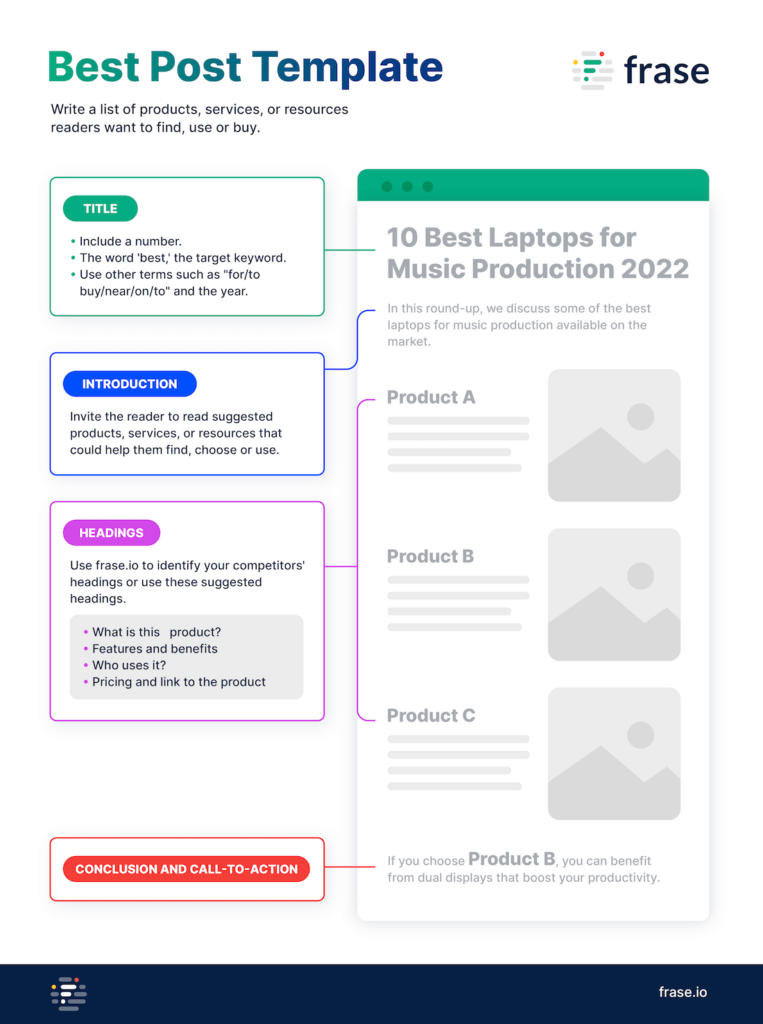
Best post conclusion
You can leave the conclusion to your writer or provide a specific conclusion and call to action.
E.g., There isn’t one best keyword, but ideally, one should have the following benefits.
Example:
This is an excellent conclusion with an opinion.
“That’s it! I would say my favorites were for sure the throw blanket and the potholders.”
Examples of best posts
- The 20 Best Airbnb’s in Canberra, Australia
- Top 10 Best Apps for YouTubers
- 10 Best Kiteboarding Spots Worldwide
- 21 Best Housewarming Gifts (That They Will Actually Use)
- 8 Best Small Recliners for Relaxing and Saving Space
- Best IG Tools To Help You Grow Your Audience
- Best Golf Rain Gear To Keep You Dry and Scoring In Wet Conditions
- Best Dog Car Crates Reviewed for 2021
- 10 Best Laptop for Music Production 2021
- Best golf swing trainers
Comparison (vs) post
A comparison (vs) article helps a reader evaluate the features and benefits of competing products or services before buying the right one.
Comparison (vs) post title
The comparison article title contains your keyword, product, or service followed by vs., versus, or with the competing product or service.
Example:
iPhone 12 vs. iPhone 13.
Comparison post introduction
The introduction of the comparison article should explain what you are comparing and why and encourage users to read the article.
Example:
In this post, I will put Ahrefs and SEMrush to the test.
So if you’re looking for a DEEP comparison of these two popular SEO tools, you’ve come to the right place.
Comparison post headings and subheadings
Use these suggested headings and edit the template.
The reader can learn about one product or service before moving on to the next using this heading structure.
- What is Product, Service, Company A?
- Definition
- Who is it for?
- Feature 1 (and benefits)
- Feature 2 (and benefits)
- Feature 3 (and benefits)
- What is Product, Service, Company B?
- Definition
- Who is it for?
- Feature 1 Equivalent (and benefits)
- Feature 2 Equivalent (and benefits)
- Feature 3 Equivalent (and benefits)
- A v B How do they compare?
- Compare the first feature each has in common
- Compare the second feature each has in common
- Etc
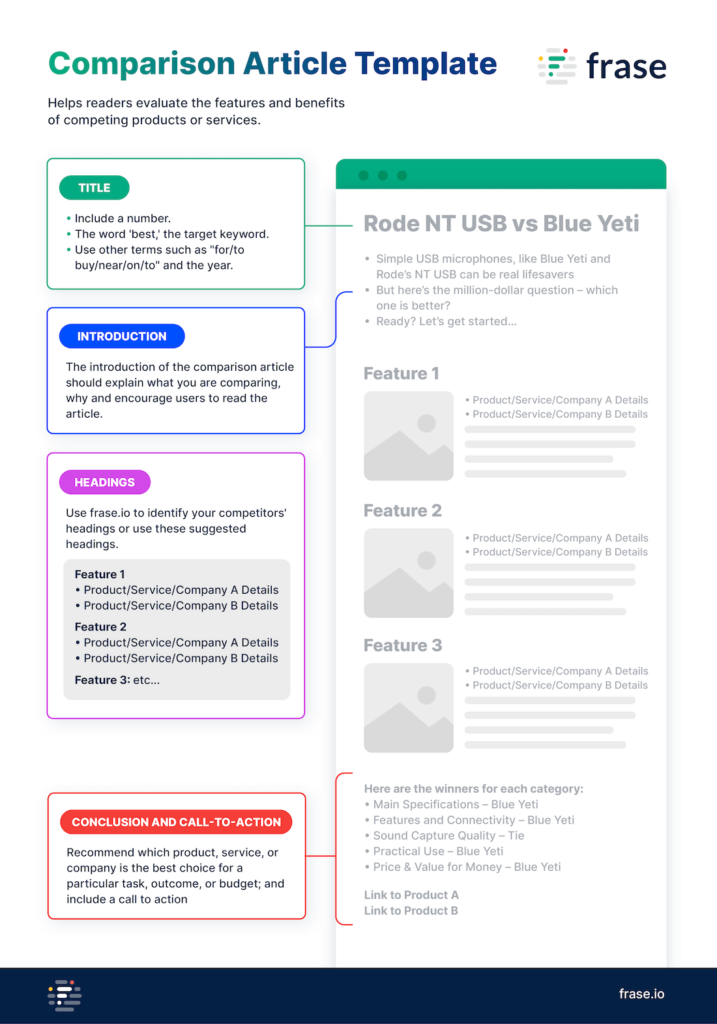
Conclusion and call to action
The conclusion should recommend which product, service, or company is the best choice for a particular task, outcome, or budget; and include a call to action.
Example:
Yeti is kind of a “Jack of all trades” where it does multiple different things equally well. Meanwhile, Rode NT USB is something more focused on voice, be it a podcast, live streaming session, or singing.
Examples of comparison posts
- Blue Yeti vs Rode
- Rode vs Blue Yeti
- Petrol vs diesel cars: Which should you buy?
- Hardwood vs Softwood: What’s the Difference?
- Ahrefs vs Semrush
How To Post
A How-to post provides readers with step-by-step instructions to get a result or outcome.
How to post title
The how-to title should start with “how-to,” including your primary keyword, number of steps, and a result or outcome.
Example:
“How to help elderly people avoid scams” although this title should really include the number of steps.
Introduction to a how to post
Invite the reader to learn about the target keyword and the benefits or outcome by following the instructions in this article.
The introduction should include three elements:
- Learn –> “how to” –> keyword
- get a specific benefit
- from these number of step-by-step instructions
Example:
Just to blow our own trumpet, this introduction explains the benefit of reading the article.
“Learn how to refresh content to better rank existing pages with these 7 easy steps.”
How to post headings and subheadings
Use these suggested headings and edit the template.
- What is the target keyword?
- Step 1 (followed by instructions)
- Step 2 (followed by instructions)
- Step 3 (followed by instructions)
- etc
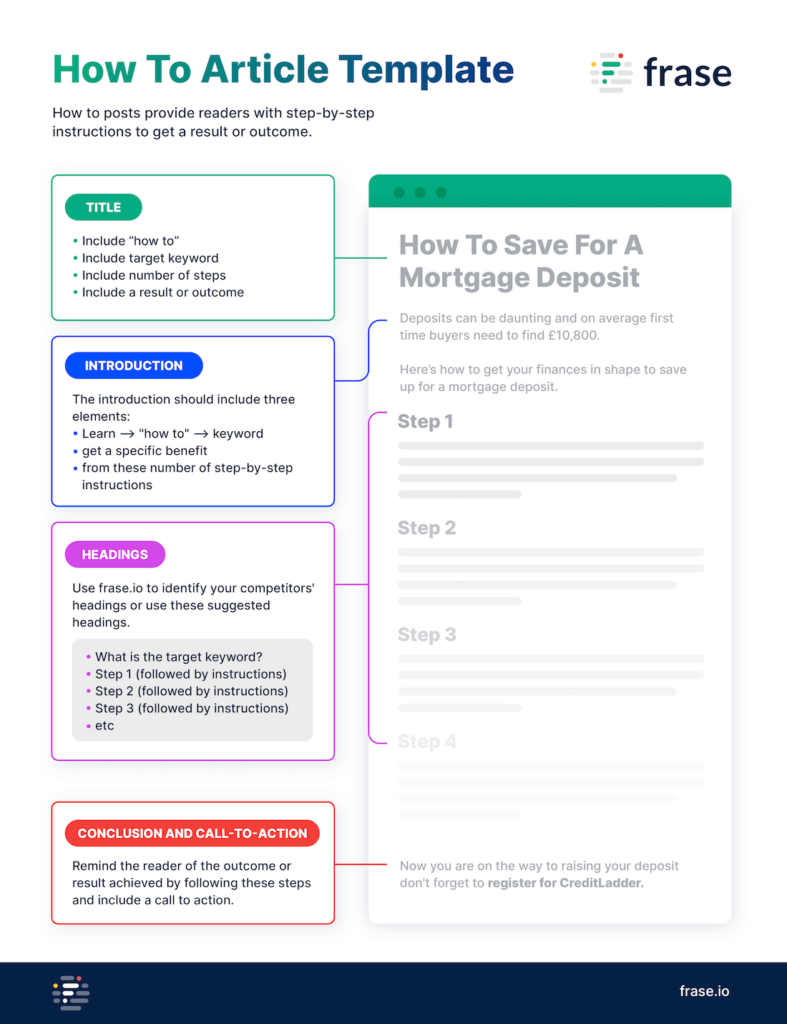
Conclusion to a how to post
Remind the reader of the outcome or result that is achieved by following these chronological steps and include a call to action.; you can leave this up to your writer or provide a specific conclusion and call to action.
Example:
This conclusion from CreditLadder reinforces the outcome and offers the next step.
Now you are on the way to raising your deposit …. CreditLadder also runs a free mortgage application service which will tell you how much you could borrow.
Examples of how to posts
- How to save for your mortgage deposit
- How to Wear Headphones Properly
- How to Find Cheap Train Tickets
- How to send an engaging follow-up email after your interview
Listicle blog post
A listicle or list post contains a numbered list of recommended resources, products, services, or tips that benefit a reader.
List post title
The listicle title should contain a number and include the target keyword.
Example:
A simple title including a number and the keyword “11 Best Skinny Jeans for Women“.
Introduction to a list post
Write a short introduction such as “In this post, we provide a number, keyword, and how you will benefit from them.”
Example:
“Finding the best mortgage” is the benefit of this introduction.“
“Use our comparison tool to find the best buy to let mortgage rates available.”
Headings and subheadings
Use these suggested headings and edit the template.
- List Item 1
- what is it
- how to use it
- supporting resources
- List Item 2
- what is it
- how to use it
- supporting resources
- List Item 3 etc
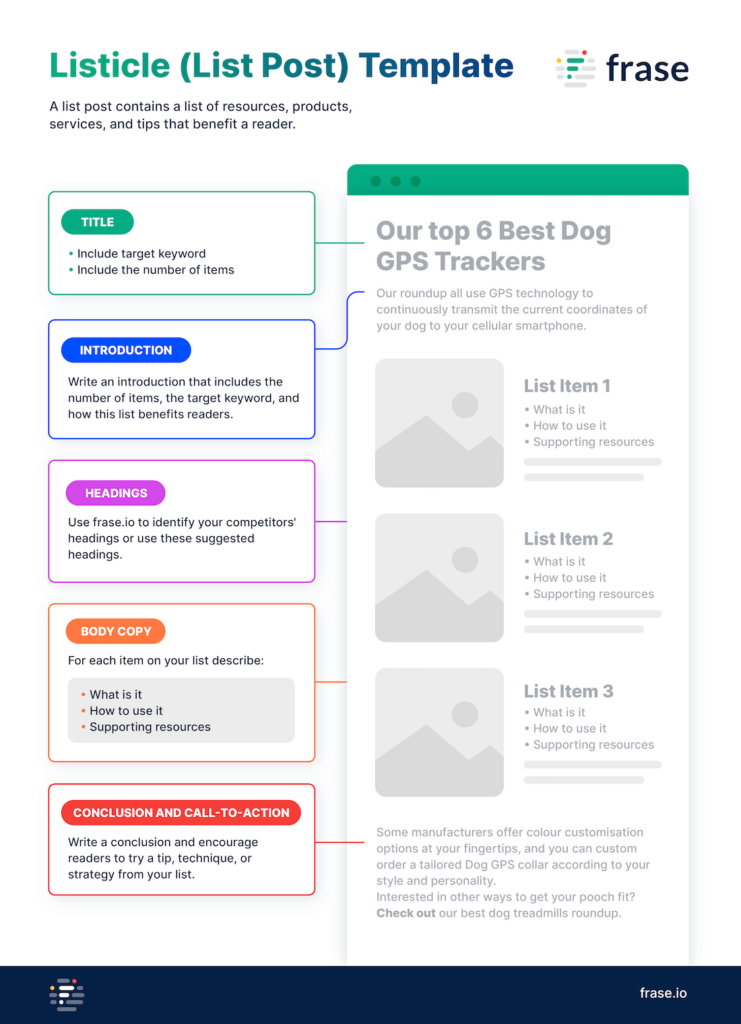
Writing a conclusion for a list post
Wrap up your post with a great conclusion.
Readers should be encouraged to take action; ask them to try a single tip, technique, or strategy from your list.
Example:
The conclusion of this piece recommends two solutions and has a subscription box below.
Rocket.Chat and Zulip are both worth looking into, if not as feature-complete as Mattermost.
Examples of list posts
- Best Marketing Newsletters
- Best Team Chat Apps
- Best Buy To Let Mortgages
- Best Skinny Jeans for Women
- The 10 Best Small Condenser Tumble Dryers In The UK
- Best Table Top Patio Heater: Top 7 Outdoor Table Heaters Reviews
- The 6 Best Dog Trackers | GPS Dog Trackers UK | Buyers Guide
- Top 10 Best Surf Poncho (Hooded Towels Review Guide)
Pillar Post
A pillar page is everything a reader needs to know about a topic. Pillar pages link out to cluster pages that are more in-depth articles about specific subtopics.
Pillar post title
Include your primary keyword and Ultimate, Definitive, or Comprehensive phrases in the page title.
Example:
A really simple intro containing the target keyword and “ultimate” – Instagram Marketing: The Ultimate Guide.
Pillar post introduction
The introduction to a pillar page should include:
- Explain the topic and why it is important
- How to keyword
- Why you are qualified to write about keyword
Example:
Read this pillar page introduction that explains why the topic is important.
“Email marketing is a type of direct marketing that uses personalized, mass emails to educate and convince a lead to take a specific action, like making a purchase.
Let’s dive into the most comprehensive guide to email marketing on the entire internet“.
Headings and subheadings
(choose from some of these proposed headings)
- What is the target keyword?
- Include a definition of the keyword.
- Why does it matter?
- Explain why your readers should care about or benefit from reading your content.
- Background
- Elaborate on the background of what you’re writing about and how the concept has developed from its inception to today.
- Terms to know about
- List out and define a few of the key terms about your topic, especially if they’re mentioned elsewhere in the post.
- Pros and cons
- If your topic has pros and cons, outline those pluses and minuses here.
- Examples/Tips
- Break down a few best practices on approaching the concept and/or a few tips or reminders about it.
- How to do a task
- If your pillar page is dedicated to a concept that requires or benefits from a step-by-step process, outline those steps in this section.
- FAQS
- Include any FAQs found in the SERP Analysis.
- Analysis/results of keyword
- If your topic relates to business or businesses, outline how and why to analyze it and how to distinguish between good and bad in the analysis.
- Resources
- Provide further reading or resources for people just getting started who may want additional information.
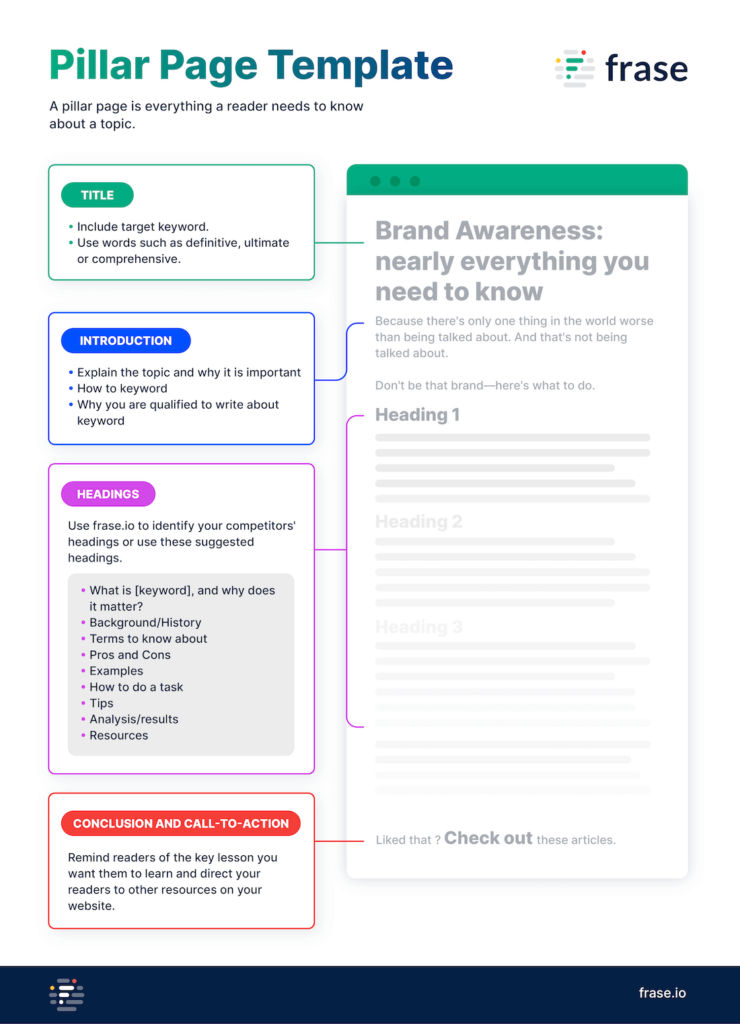
Writing a conclusion to a pillar post.
Remind your readers of the key takeaway you want them to walk away with, and consider pointing them to other resources on your website.
Example:
The conclusion.
We hope this guide has helped you learn how to create an effective email marketing campaign.”
This CTA to other resources.
“If you like this definitive guide, you’ll LOVE OptinMonster University. Check it out. It’s FREE for OptinMonster customers!”
Examples of pillar posts
Things to Do Before (or After)
As it sounds, a thing to do after, during, or before an article provides readers with action steps.
Things to Do Before (or After) post title
A Things To Do After “X” post title should include a number, keyword, and “do after.”
Example:
“13 things to do after running a marathon.”
Introduction
Introduce the steps or things readers can do after starting, completing, or purchasing something related to the target keyword.
“So you’ve just finished <keyword>. What should you do next? Today I/we are going to show you a number of steps/things to do next.“
Example:
Read the introduction to this guitar guide.
“If you received a new guitar as a gift this year, it’s important to know what to do with a brand new guitar.
Here are five things you must do when you get a new guitar.”
Headings and subheadings
Each thing should explain what the reader needs to do, why it’s important, and describe how to action the step or provide an example.
Use these suggested headings and edit the template.
- Step 1
- Why is this step important
- Example
- Tips
- Step 1
- Why is this step important
- Example
- Tips
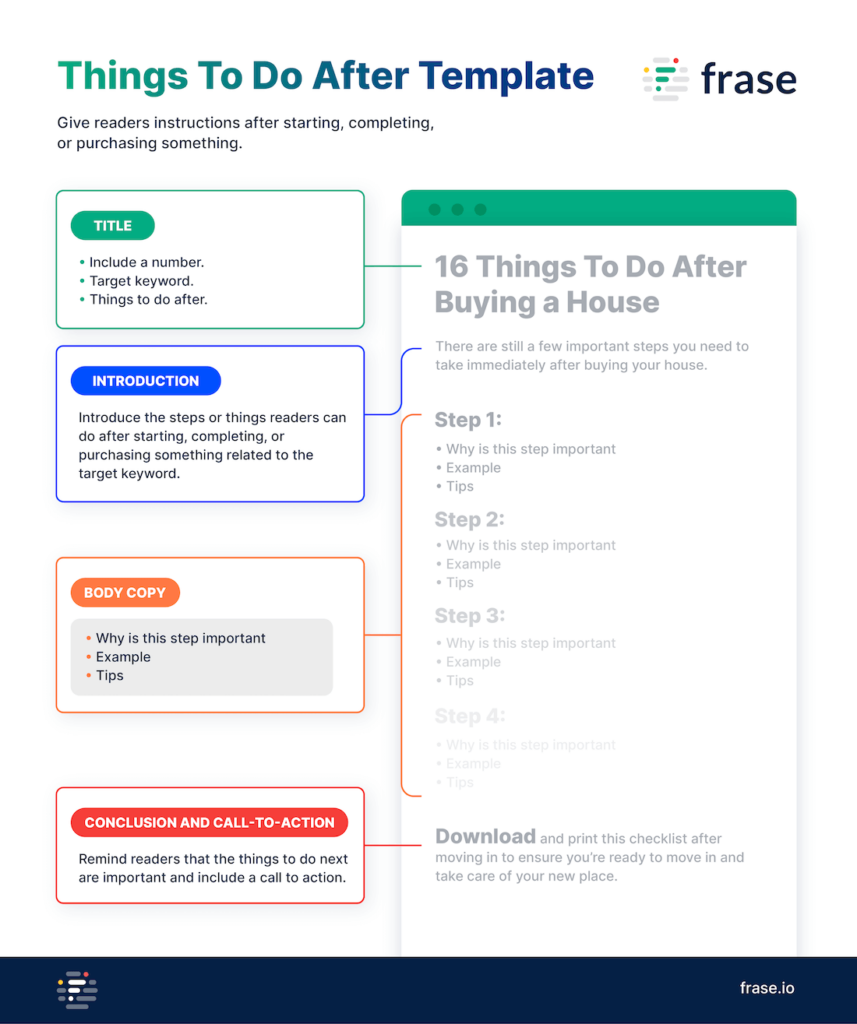
Conclusion and call to action
Remind readers that the things to do next are important and include a call to action.
Example:
This article concludes by offering a handy checklist.
Download and print this checklist after moving in to ensure you’re ready to live in and take care of your new place.
Examples of ‘things to do’ articles
- 5 Things You Must Do With Your New Guitar
- Things to do after buying a house.
- Actually Fun Things to Do in Atlanta After Dark
- 11 Things You Should Never Do After Coloring Your Hair
What Is post
A “what is or definition post” article answers “what is” or definition search queries.
What is post title
Start your page title with “what is” and include your keyword.
Example:
This is maybe too simple a page title” What Is a Key Fob?“
Introduction to a what is post
The introduction to a “what is” post should include:
- – Define the [keyword]
- – How [keyword] is used
- – Get started with [keyword]
“In this post, we’ll define what keyword is, show a few examples of how the keyword is used, and provide several ways for getting started with keyword to get benefit/outcome.”
Example:
Here’s a page introduction that follows the introduction formula.
“What is a key fob? In today’s TechTalk article, we’ll look more deeply into that question, and we’ll talk about the many aspects of key fobs you might not have been aware of. We’ll also discuss why key fob cases are an important part of an RFID key fob system and how to choose the right one.“
Headings and subheadings
Use these suggested headings and edit the template.
- What is the keyword?
- Answer the question posed by this heading.
- After the brief definition, dive further into the concept and add more context and explanation if needed.
- Why is the keyword important?
- Provide your readers with a few reasons why they should care about or benefit from the term or the concept you’re writing about.
- List out these reasons in subheadings.
- Types of keyword/concept
- List and explain any types of the keyword or concept, e.g., types of air conditioning systems.
- Examples of keyword/concept
- list a few examples of the concept you’re explaining.
- Tips about keyword
- Break down a few best practices on approaching the concept and/or a few reminders about it. Keep the list to three to five pieces of advice.
- In this example, the author provided tips about checking broadband speed and how to improve it.
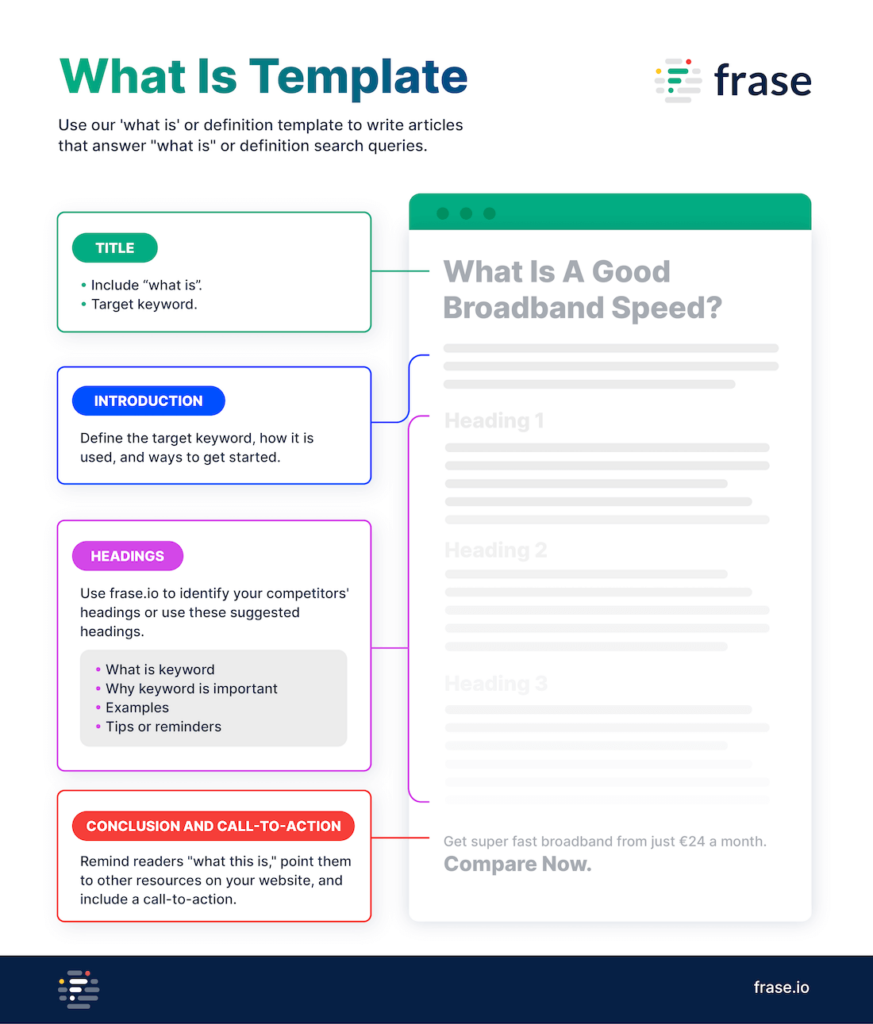
Conclusion
Remind readers “what this is,” point them to other resources on your website, and include a call-to-action.
Example:
This article concludes by pointing readers to start saving and finding cheaper deals.
Examples of ‘what is’ posts
Myth debunker post
SEOs and content writers can use the myth debunker template to write an article that debunks common myths or mistruths about a topic, category, industry, product, or service.
Post title
The myth debunker page title includes a myth, the number of myths the article covers, and who needs to know.
Example:
8 Myths about Marketing every CEO need to know before launching a SAAS.
Introduction
Introduce how the article will reveal the truth about myths related to the target keyword.
If you think the [keyword ] is a myth, then we/I have news for you.
We/I are going to reveal the truth about the keyword/myth”.
Example:
This article sort of follows our introduction formula.
“The hype around AI has produced many myths, in mainstream media, in board meetings, and across organizations. Some worry about an “almighty” AI that will take over the world, and some think that AI is nothing more than a buzzword. The truth is somewhere in the middle.”
Headings and subheadings
Use these suggested headings and edit the template.
- Myth 1
- Background
- Evidence
- Why myth is a myth
- What to do instead
- Myth 1
- Background
- Evidence
- Why myth is a myth
- What to do instead
- Myth 3 etc
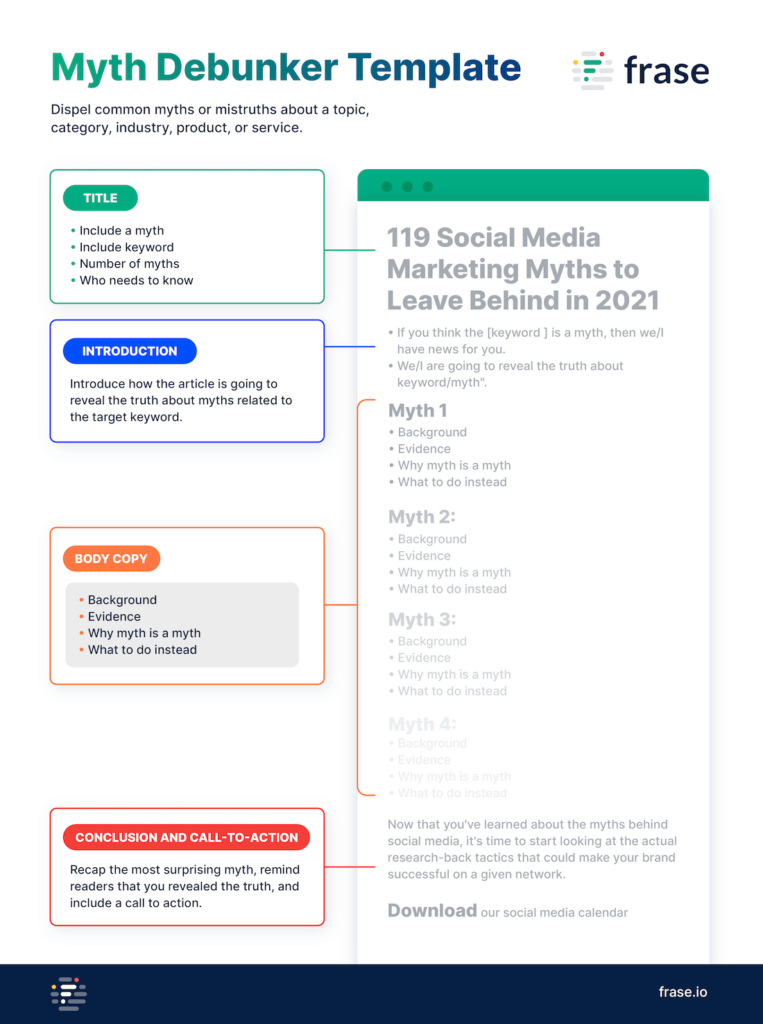
Conclusion and call to action
Recap the most surprising myth, remind readers that you revealed the truth, and include a call to action.

1 comment
For the reason that the admin of this site is working, no uncertainty very quickly it will be renowned, due to its quality contents.